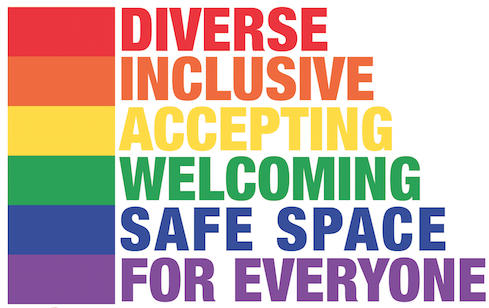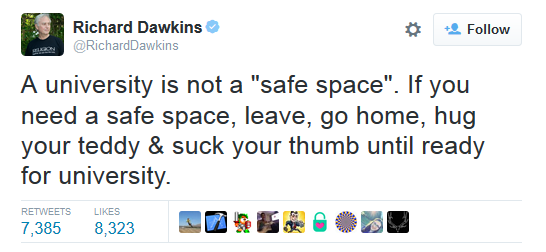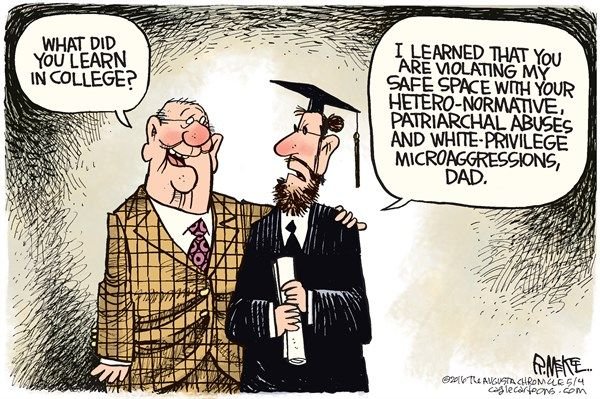Preparing the future for failure:
Safe Spaces - The Dystopian Infantilization of America's Youth (Part 1)

I'm Rubber, You're Glue
I am immensely thankful that when I was growing up there was no such thing as a "safe space" at school. The only safe space was at home and frequently, in the face of conflict within the household, the bedroom. Back then, it was considered a virtue to be able to stand your ground in the face of adverse circumstances, to argue for your point of view and to listen to other perspectives even if you disagreed with them or they made you feel uncomfortable. Retreating behind my mother's skirts or hiding behind my father became something that was simply not allowed after the age of five or six unless there was a demonstrable physical danger.
The playground refrain of the day, when someone would say something that was intended to hurt your feelings or insult you, was "I'm rubber, you're glue, what you say bounces off me and sticks to you!" Today even this immature coping mechanism has been abandoned in favor of telling authority figures so they will silence the critic or retreating to safe spaces. Sadly, this latter "solution" has not only propagated itself in elementary schools, but at universities as well.
In the 1970s and 1980s there were no emotional "safe spaces" outside the home - the term didn't even exist in its current iteration. In recent years however, a movement has arisen that advocates public spaces be partitioned and areas thereof dedicated to accommodating and coddling those who are incapable of coping emotionally or intellectually with divergent opinions or objective realities they wish weren't true.
But what exactly are "safe spaces" and how are they supposed to work?
Defining 'Safe Spaces' - Doublethink Indoctrination?
Let's start with the Merriam-Webster Dictionary definition:
(A 'safe space' is): a place (as on a college campus) intended to be free of bias, conflict, criticism, or potentially threatening actions, ideas, or conversations.
This ostensibly neutral formulation can be supplemented by the definition provided by geekfeminism.wikia, ostensibly an advocate of safe space ideology:
'Safe space' is a term for an area or forum where either a marginalised group are not supposed to face standard mainstream stereotypes and marginalisation, or in which a shared political or social viewpoint is required to participate in the space.
The idea that a 'safe space' require a shared political or social viewpoint to participate in it makes it clear that an expectation of ideological conformity exists in such spaces.
What more can we discern? The other terms used to define safe spaces indicate they are zones of exclusion, not inclusion. How do I come to this conclusion? As can be seen in the definitions above, a 'safe space' is defined with the aid of a number of terms that enable considerable interpretational freedom: a 'marginalized group', the 'mainstream', 'bias', 'criticism' or 'potentially threatening actions, ideas or conversations' are most certainly subjective terms.
It was precisely this interpretive ambiguity that I recently found myself contemplating while considering a "safe space" sign from the internet that had been posted in public at one of my alma maters. My first impression was that it could only have been designed in a modern Ministry of Truth echo chamber. Given my perspective, everything it said appeared twisted in accordance with some dystopian logic so as to mean the exact opposite of what it said, all the while earnestly proclaiming "We are inclusive and accepting!"
This is the sign that triggered my consideration of the topic (irony intended) which was found with a simple internet search, as this sign is apparently very popular today.

This is a new Treachery of Images writ large. Instead of reading "This is not a pipe" and being able to reconcile the statement with the fact that it was merely an image of a pipe, the safe space sign (for me) had no conceivable logical explanation for its fundamental contradictions other than a lack of intellectual integrity on the part of its creators.
Now don't get me wrong. I understand what safe spaces are supposed to be or represent; namely spaces where people of diverse ethnicities, sexualities and genders can retreat to in order to feel supported and cared for. But the categories of ethnicity, sex and gender seem to be the maximum extent of diversity that is accepted or welcomed and even then I think we can all recognize the limits of that "diversity".
Diversity in the context of a safe space does not mean that diversity of opinion, perspective, religion or political belief are welcome or accepted - all of which are admittedly much more varied than ethnicity, sex and gender (well, gender has apparently gone LGBTQ-to-Infinity so ...). Thus the claim to be diverse, inclusive, accepting and welcoming for everyone is patently false and must surely be recognizable as such by the promoters of these spaces. If that isn't doublethink, what is?
The cognitive dissonance evoked could only be resolved by postulating two reasons for the intrinsic contradictions: 1. the creators of the sign were functionally illiterate or 2. they are deeply indoctrinated into a doublethink ideology (which I consider more likely). Either way, the propagation of such obvious dishonesty in a supposedly intellectual space (a university campus) had exactly the opposite effect of that intended: I was triggered (/sarcasm).
Why do I contend the sign's representation of safe spaces is intellectually dishonest? Let's take a look:
Safe Spaces are Zones of Sanctioned Discrimination and Segregation
The dictionary definition provides us with vague waypoints for identifying what a safe space is meant to exclude. The intention to create a zone free of bias, conflict, criticism, threatening actions, ideas or conversations appears imminently reasonable. But what kind of bias, conflict or criticism is meant? Which 'potentially threatening actions, ideas or conversations' are intended? That even the mere 'potential' of threat is to be obviated makes it clear that subjective interpretation is the defining criteria for what a 'safe space' should be. (As far as I can tell, if this is the definition of a safe space, human beings are not allowed in safe spaces).
Safe spaces are however highly contextualized in the current educational environment, perhaps the definition provided by geekfeminism above can be of further assistance.
If I am not mistaken, 'marginalized groups' as intended by geekfeminism means racial, ethnic and LGBTQ-to-Infinity "minorities", an admittedly US culturo-centric view that predicates the "majority" as marginalizing, i.e. intolerant and oppressive (even if unintentionally so because "white privilege"). 'Mainstream' too is almost certainly meant to reference what could be understood as the 'white, cis-gendered, heteronormative, democratic, meritocratic, free-market capitalism' paradigm nominally participated in and ascribed to by a majority of the population. Is this to mean that safe spaces are meant to exclude individuals who sympathize, identify with or practice these preceding characteristics and are willing to exercise their right to free speech to defend or promote the same? It would appear so.
(The irony here is that "mainstream" and "social" media have for years been actively promoting or providing a platform for violent/racist ideologies, promoting the LGBTQ-to-Infinity narrative and in some cases has become a fifth column advocate of political violence seeking to discredit the Constitution of the United States.)
This is a strong indication that safe spaces are not about promoting inclusivity, tolerance, diversity or even rational discourse, but rather about infantilizing the cognitive functioning of their participants and providing them with an emotional environment in which developing maturity and coping skills are not only unnecessary but actively hindered. Just as parents try to obviate potential threats in a toddler's surroundings, safe spaces try to achieve the same in an emotional and intellectual framework for adults. This appears to be the promotion of learned helplessness or the perhaps fear to advance social division and create dependency in what should be independently thinking adults. Followers, not leaders, are what are desired and being produced on college campuses today.
Safe Spaces and The Conspiracy of Oppression
As Judith Shulevitz pointed out in the NYT:
In most cases, safe spaces are innocuous gatherings of like-minded people who agree to refrain from ridicule, criticism or what they term microaggressions — subtle displays of racial or sexual bias — so that everyone can relax enough to explore the nuances of, say, a fluid gender identity. As long as all parties consent to such restrictions, these little islands of self-restraint seem like a perfectly fine idea.
But the notion that ticklish conversations must be scrubbed clean of controversy has a way of leaking out and spreading. Once you designate some spaces as safe, you imply that the rest are unsafe. It follows that they should be made safer. source
And these two paragraphs include crucial considerations that were not taken to their logical conclusions: First, if an individual does not consent to restricting their thought processes or forms of expression, they are not welcome in a safe space. Second, the implication that all other spaces are not safe entails that those who gladly occupy those "other spaces" are perpetrators or co-conspirators of some form of oppression or discrimination. Ominously, the form of discrimination can be arbitrarily determined to legitimize the safe space ethos at any time.
This exclusionary and discriminatory tendency is demonstrated in every safe space organizer's limitations on access to the respective safe space that I have seen (though of course I have not seen all safe space guidelines). There are countless examples of this exclusionary aspect, but perhaps the most glaringly discriminatory is that of the University of Minnesota's "Tongues Untied" safe space that is reserved "exclusively for 'People of Color who identify as LGBTQIA and/or Same-Gender-Loving" (sic) and explicitly excludes access for any white students, straight students, or LGBTQ advocates who are not themselves a person of color and self-identify as LGBTQ(-to-Infinity).
Interim Conclusion - Safe Spaces are Promoting Segregation on the Public's Dime
By all appearances, safe spaces seem to do exactly the opposite of what they claim. They promote prejudice, isolation and exclusion, sympathize with and advocate intolerance for other perspectives and life choices, demand ideological orthodoxy and conformity to whatever safe space credo is being espoused and ultimately privilege subjective beliefs over objective realities. It is difficult to conceive of a more divisive and disempowering approach to dealing with real or perceived differences between individuals and groups.
I understand the need for safe spaces and I even advocate them in the privacy of the home or in a space that is privately paid for. But I am very much opposed to using public tax money to pay for "safe spaces" on campus or elsewhere where heterodox thought and belief systems are excluded because some people are simply not mature enough to deal with conflict, distressing thoughts or opposing viewpoints like rational adults. Nor should public funds be used to pay salaries to supervise, host or promote such closed / segregated social movements. Public taxpayer funded spaces are not "safe spaces" from divergent opinions, nor should they be.

I partitioned this contribution due to length, stay tuned for "Safe Spaces - The Dystopian Infantilization of America's Youth (Part 2)" - Now live!

.
.
.
Shot with a golden arrow,
.
.

.
.
.
.
Don't forget to upvote, follow and resteem! Comments always appreciated.
.
.
.
All gifs courtesy of Giphy

